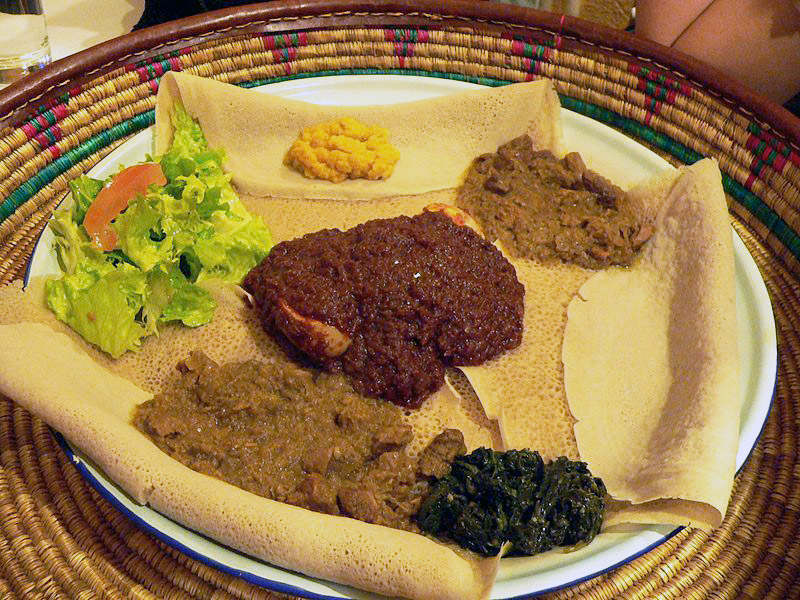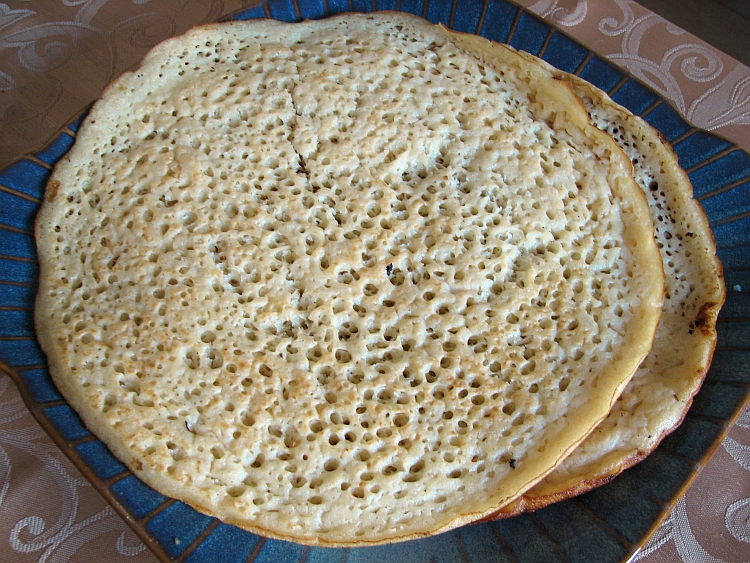|
Pannekoek
A pannenkoek (; plural ''pannenkoeken'' ) or Dutch pancake is a style of pancake with origins in the Netherlands. Pannenkoeken are usually larger (up to a foot in diameter) and much thinner than their American or Scotch pancake counterparts, but not as thin as crêpes. They may incorporate slices of bacon, apples, cheese, or raisins. Plain ones are often eaten with treacle (syrup made of sugar beets), ''appelstroop'' (an unspiced Dutch variety of apple butter) or (powdered) sugar and are sometimes rolled up to be eaten by hand or with cutlery. Basic ingredients are flour (plain, self-rising or both), milk, salt, and eggs. The addition of buckwheat flour (up to 50 percent) is traditional, but much less common nowadays. Milk can be replaced with soy milk without changing the end result. The ingredients are beaten into a batter of a fairly liquid consistency. A ladle of batter is then pan fried in butter or oil. Once the top of the pannenkoek is dry and the edges start to brown ... [...More Info...] [...Related Items...] OR: [Wikipedia] [Google] [Baidu] |
Pancake
A pancake, also known as a hotcake, griddlecake, or flapjack, is a flat type of batter bread like cake, often thin and round, prepared from a starch-based Batter (cooking), batter that may contain eggs, milk, and butter, and then cooked on a hot surface such as a griddle or frying pan. Archaeological evidence suggests that pancakes were probably eaten in prehistoric societies. The pancake's shape and structure varies worldwide. In England, pancakes are often Leavening agent, unleavened and resemble a crêpe. In Scotland and North America, a leavening agent is used (typically baking powder) creating a thick fluffy pancake. A ''crêpe'' is a thin pancake of Brittany, Breton origin cooked on one or both sides in a special pan or crepe maker to achieve a lacelike network of fine bubbles. A well-known variation originating from southeast Europe is palatschinke, a thin moist pancake fried on both sides and filled with jam, cream cheese, chocolate, or ground walnuts, but many other f ... [...More Info...] [...Related Items...] OR: [Wikipedia] [Google] [Baidu] |
Scotch Pancake
A pancake, also known as a hotcake, griddlecake, or flapjack, is a flat type of batter bread like cake, often thin and round, prepared from a starch-based batter that may contain eggs, milk, and butter, and then cooked on a hot surface such as a griddle or frying pan. Archaeological evidence suggests that pancakes were probably eaten in prehistoric societies. The pancake's shape and structure varies worldwide. In England, pancakes are often unleavened and resemble a crêpe. In Scotland and North America, a leavening agent is used (typically baking powder) creating a thick fluffy pancake. A ''crêpe'' is a thin pancake of Breton origin cooked on one or both sides in a special pan or crepe maker to achieve a lacelike network of fine bubbles. A well-known variation originating from southeast Europe is palatschinke, a thin moist pancake fried on both sides and filled with jam, cream cheese, chocolate, or ground walnuts, but many other fillings—sweet or savoury—can also ... [...More Info...] [...Related Items...] OR: [Wikipedia] [Google] [Baidu] |
Crêpe
A crêpe or crepe ( or , , ) is a dish made from unleavened batter or dough that is cooked on a frying pan or a griddle. Crêpes are usually one of two varieties: ''sweet crêpes'' () or ''savoury galettes'' (). They are often served with a wide variety of fillings such as cheese, fruit, vegetables, meats, and a variety of spreads. Crêpes can also be flambéed, such as in crêpes Suzette. Etymology The French term "" derives from , the feminine version of the Latin word , which means "curled, wrinkled, having curly hair." Traditions In France, crêpes are traditionally served on the Christian holiday Candlemas (), on February 2. On that day in 472, Pope Gelasius I offered crepes as sacramental bread to French pilgrims that were visiting Rome for the Chandeleur. The sacramental bread was replaced by crêpes in France, and the day became known as "Le Jour des Crêpes" ("The Day of the Crêpes"). The day is also celebrated by many as the day that marks the transiti ... [...More Info...] [...Related Items...] OR: [Wikipedia] [Google] [Baidu] |
Flaugnarde
Flaugnarde () also known as flagnarde, flognarde or flougnarde, is a baked French dessert with fruit arranged in a buttered dish and covered with a thick flan-like batter. Similar to a clafoutis, which is made with black cherries, a flaugnarde is made with apples, peaches, pears, plums, prunes or other fruits. Resembling a sweet batter pudding or large pancake, the dish is dusted with confectioner's sugar and can be served either warm or cold. Origins The name is derived from the Occitan words ''fleunhe'' and ''flaunhard'',Frédéric Mistral, ''Lou Tresor dóu Felibrige'': FLAUNHARD: (rom. ''flaugnard'') Mignard avec niaiserie, qui se plaint pour peu de chose, douillet, faible, indolent which both translate as "soft" or "downy". The dish is common in the Auvergne, Limousin and Périgord Périgord ( , ; ; or ) is a natural region and former province of France, which corresponds roughly to the current Dordogne department, now forming the northern part of the administ ... [...More Info...] [...Related Items...] OR: [Wikipedia] [Google] [Baidu] |
Indonesia
Indonesia, officially the Republic of Indonesia, is a country in Southeast Asia and Oceania, between the Indian Ocean, Indian and Pacific Ocean, Pacific oceans. Comprising over List of islands of Indonesia, 17,000 islands, including Sumatra, Java, Sulawesi, and parts of Borneo and New Guinea, Indonesia is the world's largest archipelagic state and the List of countries and dependencies by area, 14th-largest country by area, at . With over 280 million people, Indonesia is the world's List of countries and dependencies by population, fourth-most-populous country and the most populous Islam by country, Muslim-majority country. Java, the world's List of islands by population, most populous island, is home to more than half of the country's population. Indonesia operates as a Presidential system, presidential republic with an elected People's Consultative Assembly, legislature and consists of Provinces of Indonesia, 38 provinces, nine of which have Autonomous administrative divisi ... [...More Info...] [...Related Items...] OR: [Wikipedia] [Google] [Baidu] |
Hagelslag
(, ; ) are small, oblong, sweet-tasting chocolate granules, a few millimetres long, which are sprinkled on slices of buttered bread or rusks. is traditionally eaten by the Dutch for breakfast or lunch. can be difficult to find in other countries, with the exception of Suriname, Belgium, the former Netherlands Antilles and Indonesia (all of which were former Dutch colonies), where one can buy in stores. In those regions, customers generally use to decorate desserts and cakes. is also available in the ethnically Dutch communities of New Zealand, such as Foxton in the Manawatū, where it is widely available. In Belgium they are commonly called ''muizenstrontjes'' (mouse droppings). Another variant is '' vlokken'' ("flakes"), chocolate flakes to sprinkle on buttered bread. There is a variety of flavors of , such as (dark chocolate), (white chocolate) and (milk chocolate), and even (fruit flavoured). An estimated 750,000 hagelslag sandwiches are eaten each day in the ... [...More Info...] [...Related Items...] OR: [Wikipedia] [Google] [Baidu] |
Clafoutis
Clafoutis (; or ), sometimes spelled clafouti in Anglophone countries, is a French dish of fruit, unpitted black cherries, arranged in a buttered dish, covered with a thick but pourable batter, then baked to create a crustless tart. The clafoutis is traditionally dusted with powdered sugar and served tepid, sometimes with cream, as a dessert. It can also be served as a breakfast or brunch main or side dish. It originates in the Limousin region. Etymology One proposed derivation of the dish's name is from the Occitan ''clafotís'', from the verb ''clafir'', meaning "to fill" (implied: "the batter with cherries"). Another is that ''clafir'' comes from the old French ''claufir'', meaning "to fix with nails," explained as the cherries having the appearance of nail heads. Cyanide A traditional Limousin clafoutis contains both the flesh of the cherries and the nut-like kernels. Cherry kernels contain benzaldehyde, the compound responsible for the dominant flavour in almond e ... [...More Info...] [...Related Items...] OR: [Wikipedia] [Google] [Baidu] |
Netherlands
, Terminology of the Low Countries, informally Holland, is a country in Northwestern Europe, with Caribbean Netherlands, overseas territories in the Caribbean. It is the largest of the four constituent countries of the Kingdom of the Netherlands. The Netherlands consists of Provinces of the Netherlands, twelve provinces; it borders Germany to the east and Belgium to the south, with a North Sea coastline to the north and west. It shares Maritime boundary, maritime borders with the United Kingdom, Germany, and Belgium. The official language is Dutch language, Dutch, with West Frisian language, West Frisian as a secondary official language in the province of Friesland. Dutch, English_language, English, and Papiamento are official in the Caribbean Netherlands, Caribbean territories. The people who are from the Netherlands is often referred to as Dutch people, Dutch Ethnicity, Ethnicity group, not to be confused by the language. ''Netherlands'' literally means "lower countries" i ... [...More Info...] [...Related Items...] OR: [Wikipedia] [Google] [Baidu] |
Kaiserschmarrn
() or (; ) is a lightly sweetened pancake that takes its name from the Austrian emperor (Kaiser) Franz Joseph I, who was fond of this fluffy shredded pancake. It is served as a dessert or as a light lunch alongside apple sauce and contains raisins or dried cranberries. is a popular meal or dessert in Austria, Bavaria, and many parts of the former Austro-Hungarian empire, e.g. Hungary, Slovenia, Czech Republic, northern Croatia and western Romania, which usually use the name as a loan word or translations of it. In Slovenia, it is called or . Its Hungarian name is or ; its Czech name is or . In Slovak it is called ; Its Romanian name is ''șmoră''. Etymology The name ' is a compound of the words () and (a scrambled or shredded dish). is also a colloquialism used in Austrian and Bavarian to mean . The word may be related to () and ( schmear.html" ;"title="ee ''schmear">ee ''schmear''. Description is a light, caramelized pancake made from a sweet batter ... [...More Info...] [...Related Items...] OR: [Wikipedia] [Google] [Baidu] |
Okonomiyaki
is a Japanese ''teppanyaki'' savory pancake dish consisting of wheat flour batter and other ingredients (mixed, or as toppings) cooked on a '' teppan'' (flat griddle). Common additions include cabbage, meat, and seafood, and toppings include ''okonomiyaki'' sauce (made with Worcestershire sauce), '' aonori'' (dried seaweed flakes), ''katsuobushi'' (bonito flakes), Japanese mayonnaise, and pickled ginger. ''Okonomiyaki'' is mainly associated with two distinct variants from Hiroshima or the Kansai region of Japan, but is widely available throughout the country, with toppings and batters varying by area. The name is derived from the word , meaning "how you like" or "what you like", and , meaning "grilled". It is an example of ( in the Kansai dialect), or flour-based Japanese cuisine. It is also called by an abbreviated name, "okonomi", where the is a politeness prefix and means 'favorite'. A liquid-based ''okonomiyaki'', popular in Tokyo, is called '' monjayaki'' (also wri ... [...More Info...] [...Related Items...] OR: [Wikipedia] [Google] [Baidu] |






